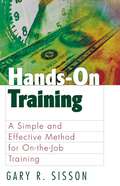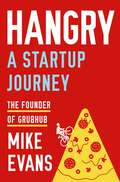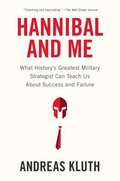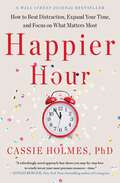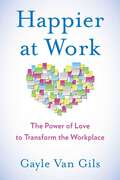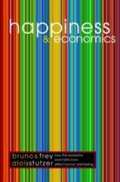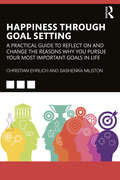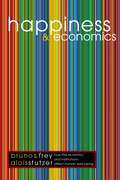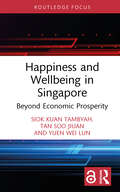- Table View
- List View
Hands-On Training: A Simple and Effective Method for on the Job Training
by Gary R. SissonOn-the-Job Training (OJT) is the single most used training method in organizations today. But it is also the most misused-because very few of those doing OJT are ever trained how to do it. In Hands-On Training Gary Sisson draws on his thirty-five years of experience to lay out a simple, systematic approach to OJT that can be understood and applied by anyone in any organization-- managers, line or staff supervisors, employees and both internal and external human resource and training professionals.
HandsOn Bay Area: Scaling Up Community Service
by James L. HeskettHandsOn Bay Area, an organization devoted to the performance of (and development of leaders for) community service, is undergoing a significant (and internally controversial) shift in its business model from "retail" projects involving individual volunteers to "wholesale" projects with for-profit partners from the San Francisco Bay Area. Its CEO has to decide whether and how to respond to a request from Google to engage 5,500 Google employees in community service activities during a one-week period. It's a far larger project than the organization has ever undertaken and one requiring many added resources. Among the risks is the possible damage to the HandsOn reputation among Silicon Valley partners if the effort does not succeed.
Handy: The Future of Work? (A)
by Nien-He Hsieh Kieron StopforthWitnessing numerous lawsuits alleging that online platform companies misclassified workers as contractors when they were actually employees, Handy's founders faced a series of decisions. Handy was an online platform business that enabled customers to book appointments with cleaners at a convenient time and check the cleaner's ratings. Started in 2012 after the founders struggled to find trustworthy, affordable cleaning services while MBA students, by 2015, Handy enjoyed considerable success. Handy was one of the emerging platform companies in the gig economy that connected customers to service providers and sought to disrupt everything from transportation to grocery shopping to deliveries. Like many of these companies, Handy classified service providers as 1099 independent contractors, rather than hiring them as W-2 employees. Doing so often meant lower labor costs for companies and greater flexibility for workers. The companies' reliance on contractors was controversial. Workers, some argued, displayed all the marks of employees - they performed work that was integral to the companies' business and companies exercised control by telling them which jobs to accept and where and by using ratings systems to influence behavior. Facing two misclassification lawsuits of their own while still pushing toward profitability, Handy's founders must decide how to respond.
Hang Lung Properties and the Chengdu Decision (A)
by Michael Shih-ta Chen John D. Macomber Keith Chi-ho WongA residential real estate developer competes in a heated auction for a prime retail development site in the interior of China during the 2009 boom. Total project cost might be in excess of $1billion US for over 4,000,000 square feet of building. Hang Lung Properties has enjoyed success in residential building in Hong Kong but has focused on very limited projects in China, notably two retail properties in Shanghai. After a decade in Shanghai the firm decides to enter second tier Chinese cities including Chengdu, a city of 11 million in interior China. The case covers Hang Lung Properties' due diligence and thought process with respect to anticipated rental income, construction costs, and land costs. The auction includes many other well capitalized firms and the price escalates. Hang Lung's team must decide whether to participate or withdraw. Students need to use judgment with respect to estimates of key variables including stabilized income, construction cost, and minimum expectations for return on investment in order to prepare their bids. The (B) case goes into further steps in the auction as well as Hang Lung Properties' internal discipline with respect to asset types, infrastructure in target cities, and baseline returns.
Hang Lung Properties and the Chengdu Decision (B)
by Michael Shih-ta Chen John D. Macomber Keith Chi-ho WongSecond phase of auction for a prime retail development parcel in Chengdu, China. Competition forces the firm to revisit all of its land purchase criteria. Hang Lung Properties is known for rigorous due diligence, for discipline in buying property, and for good understanding of market cycles. The (B) case reveals the firms assumptions in the Chengdu situation, as compared to what students had to derive on their own in the (A) case. The (B) case also reviews strategic focus with respect to asset classes and geography, as well as best practices for what to look for in cities that will be attractive for superblock mixed use projects.
Hangry: A Startup Journey
by Mike EvansNautilus Book Awards' Better Books for a Better World | Axiom Business Book Award WinnerGrubHub founder Mike Evans reveals the inside story of how he grew a multibillion-dollar behemoth that changed the way we eat. Hungry and tired one night, Mike wanted a pizza, but getting a pizza delivered was a pain in the neck. He didn&’t want to call a million restaurants to see what was open. So, as an avid coder, he created GrubHub in his spare bedroom to figure out who delivered to his apartment. Then, armed with a $140 check from his first customer and ignoring his crushing college debt, he quit his job. Over the next decade, Mike grew his little delivery guide into the world&’s premier online ordering website. In doing so, he entered the company of an elite few entrepreneurs to take a startup from an idea all the way to an IPO. GrubHub&’s journey from Mike&’s bedroom to Wall Street doesn&’t fit into how business schools teach entrepreneurship. In Hangry, he details step-by-step the grind of building an innovative business, with each chapter including sharp lessons for entrepreneurs and startups that Mike learned on the fly as he piloted GrubHub by the seat of his pants. Hangry reveals a decade of eighty-hour work weeks, detailed steps of how Mike garnered his first customers, his hunt for financing dollars, cliffhanger acquisitions, the near collapse of his marriage, a brutally difficult merger, and a pair of tumultuous quit/unquit moments, all to steer the company to become one of the most successful startups in the world. With a razor-sharp wit, Mike reveals hard-won truths about how startups succeed—and even harder-won truths about how startups fail. Shocking everyone, at the pinnacle of startup success, Mike leaves it all behind, quitting the company he started to bike across the United States in search of balance. But eventually, the grand vistas of America bring the lessons of the past into focus, driving the realization that for entrepreneurs a hunger for success doesn&’t end, and he starts another company, even more ambitious than the first.
Hank Kolb, Director, Quality Assurance
by Frank S. LeonardDesigned to introduce the systemic nature of product quality and the complexity of quality problems. Uses a new director, quality assurance, and the discovery of a quality problem. The new director has to decide if it is a real problem, what to do about it, and how to go about orienting an organization toward a better quality attitude.
Hank and Nancy: The Subprime Crisis, the Run on Lehman and the Shadow Banks, and the Decision to Bailout Wall Street
by Aldo Sesia Rafael Di Tella Alberto CavalloHank and Nancy: The Subprime Crisis, the Run on Lehman and the Shadow Banks, and the Decision to Bailout Wall Street by Rafael Di Tella, Alberto Cavallo and Aldo Sesia
Hank and Nancy: The Subprime Crisis, the Run on Lehman and the Shadow Banks, and the Decision to Bailout Wall Street
by Aldo Sesia Rafael Di Tella Alberto F. CavalloCase
Hannibal and Me: What History's Greatest Military Strategist Can Teach Us About Success and Failure
by Andreas KluthA dynamic and exciting way to understand success and failure, through the life of Hannibal, one of history's greatest generals. The life of Hannibal, the Carthaginian general who crossed the Alps with his army in 218 B. C. E. , is the stuff of legend. And the epic choices he and his opponents made-on the battlefield and elsewhere in life-offer lessons about responding to our victories and our defeats that are as relevant today as they were more than 2,000 years ago. A big new idea book inspired by ancient history, Hannibal and Me explores the truths behind triumph and disaster in our lives by examining the decisions made by Hannibal and others, including Albert Einstein, Eleanor Roosevelt, Steve Jobs, Ernest Shackleton, and Paul Cézanne-men and women who learned from their mistakes. By showing why some people overcome failure and others succumb to it, and why some fall victim to success while others thrive on it, Hannibal and Me demonstrates how to recognize the seeds of success within our own failures and the threats of failure hidden in our successes. The result is a page-turning adventure tale, a compelling human drama, and an insightful guide to understanding behavior. This is essential reading for anyone who seeks to transform misfortune into success at work, at home, and in life. .
Hans Wilsdorf and Rolex
by Geoffrey G. Jones Alexander AtzbergerExplores the creation of the Rolex watch by Hans Wilsdorf. Provides a case study of how one of the world's leading luxury brands was created and, more generally, provides a vehicle for exploring the competitive advantage of Switzerland in watchmaking (and other industries). Although Switzerland was a traditional watchmaking center, Wilsdorf-who was neither a watchmaker nor Swiss-created this successful brand through his emphasis on quality and reliability, combined with celebrity marketing.
Hans-Hugo Miebach
by George Wu Arnold HolleProvides private information for students assuming the role of Hans-Hugo Miebach in a simulated negotiation of the sale of Cementownia Odra.
Hanson Manufacturing Co.
by Robert N. Anthony Robert L. LavoieCenters on pricing, contribution to overhead, cost system.
Hanson Ski Products
by William J. Bruns Jr. Julie H. HertensteinAt the end of the budget cycle, the manager must test whether plans are feasible given financing arrangements and constraints. Cash needs are great due to seasonality. Needed loans must be calculated at five separate dates, and financial position projected. This is a rewritten version of Hanson Industries (B) and (C).
Hansson Private Label, Inc.: Evaluating an Investment in Expansion
by Erik Stafford Joel L. Heilprin Jeffrey DevolderA manufacturer of private-label personal care products must decide whether to fund an unprecedented expansion of manufacturing capacity. The decision prompts fundamental financial analysis of the potential project, including development of cash flow projections and net present value calculations. Students will be required to compute net operating profit after tax, cash investment in working capital, and ongoing capital expenditures for a proposed investment, and to discount values to the present. The case also facilitates a systematic consideration of the company's capital planning process.
Hansson Private Label, Inc.: Evaluating an Investment in Expansion
by Erik Stafford Joel L. Heilprin Jeffrey DeVolderA manufacturer of private-label personal care products must decide whether to fund an unprecedented expansion of manufacturing capacity. The decision prompts fundamental financial analysis of the potential project, including development of cash flow projections and net present value calculations. Students will be required to compute net operating profit after tax, cash investment in working capital, and ongoing capital expenditures for a proposed investment, and to discount values to the present. The case also facilitates a systematic consideration of the company's capital planning process.
Hapag-Lloyd AG: Complying with IMO 2020
by Benjamin C. Esty Emer Moloney Mette Fuglsang HjortshoejA new environmental regulation known as IMO 2020 was creating what one industry analyst called "the biggest shakeup for the oil and shipping industries in decades." According to the new regulation, all ocean-going ships would have to limit their sulfur emissions by January 1, 2020. Senior leaders at Hapag-Lloyd, one of the world's largest shipping companies, were evaluating three ways their ships could comply with the new regulation: use low sulfur fuel, use high-sulfur fuel but install scrubbers to clean the exhaust, or convert ships to use liquid natural gas (LNG) as fuel. Each of the options had its advantages and disadvantages, and the most attractive option depended on not only the values of key parameters (e.g., future fuel prices and equipment costs), but also the strategies adopted by the owners of the other 60,000 ocean-going ships subject to the regulation. For the industry as a whole, annual compliance could cost as much as $60 billion; for Hapag-Lloyd, annual compliance might cost as much as $1 billion or more. For a company with net income of $34 million ( 28 million) in the prior year, and losses in two of the past four years, getting this decision right was of the utmost importance. Senior executives at Hapag-Lloyd had created a proposed compliance plan and were scheduled to present it to the firm's supervisory board for approval in June 2018. Whether the team had the right plan and whether the board would approve it are the key questions in the case.
Happier Hour: How to Beat Distraction, Expand Your Time, and Focus on What Matters Most
by Cassie HolmesThe antidote to overscheduling and feeling like your days aren&’t your own, Happier Hour reframes your time around life&’s happiest moments to build days that aren&’t just full—but fulfilling.Our most precious resource isn&’t money. It&’s time. We are allotted just twenty-four hours a day, and we live in a culture that keeps us feeling &“time poor&” —like we never have enough. Since we can&’t add more hours to the day, how can we experience our lives as richer? Is it possible to spend our days so they aren&’t just full, but are fulfilling? Based on her wildly popular MBA class at UCLA, Professor Cassie Holmes demonstrates how to immediately improve our lives by changing how we perceive and invest our time. Happier Hour provides empirically based insights and easy-to-implement tools that will allow you to: - Optimally spend your hours and feel confident in those choices - Sidestep distractions - Create and savor moments of joy - Design your schedule with purpose - Look back on your years without regrets Enlivened by Holmes&’s upbeat narrative and groundbreaking research, Happier Hour teaches you how small changes can have an enormous impact, helping you feel less overwhelmed, more present, and more satisfied with your life overall. It all starts by transforming just one hour into a happier hour.
Happier at Work: The Power of Love to Transform the Workplace
by Gayle Van GilsThe American workplace has become toxic to mental, emotional, and physical health. A book for our complex and challenging times, Happier at Work offers a practical path for leaders and employees to shift a culture of fear and reactivity to one of communication and collaboration. Mindfulness and compassion come naturally to all of us, as does a fundamental goodness; in these pages, readers will discover how to access that true nature. Van Gils also explores the science behind practices that not only decrease stress, overwhelm, and chronic illness but also develop authentic, emotionally fit leaders and a compassionate workplace. Accessible and inspiring, Happier at Work is a guide to a transformed workplace—one of enhanced creativity, innovation, engagement, performance, and joy!
Happiness And Economics: How the Economy and Institutions Affect Human Well-Being
by Bruno S. Frey Alois StutzerCuriously, economists, whose discipline has much to do with human well-being, have shied away from factoring the study of happiness into their work. Happiness, they might say, is an ''unscientific'' concept. This is the first book to establish empirically the link between happiness and economics--and between happiness and democracy. Two respected economists, Bruno S. Frey and Alois Stutzer, integrate insights and findings from psychology, where attempts to measure quality of life are well-documented, as well as from sociology and political science. They demonstrate how micro- and macro-economic conditions in the form of income, unemployment, and inflation affect happiness. The research is centered on Switzerland, whose varying degrees of direct democracy from one canton to another, all within a single economy, allow for political effects to be isolated from economic effects.
Happiness Through Goal Setting: A Practical Guide to Reflect on and Change the Reasons Why You Pursue Your Most Important Goals in Life
by Christian Ehrlich Sashenka MilstonAn evidence-based, practical guide to reflection on the most important goals in life, this book provides a unique framework and thought-provoking exercises to modify personal and professional goals to increase happiness. Why we pursue our most important goals in life is an important question, and the answer we give ourselves greatly influences our happiness. This book presents the goal-striving reasons framework to illustrate the essential positive and negative ingredients: pleasure, altruism, self-esteem, and necessity. This new framework and the practical exercises throughout the book will enable readers to change their reasons for pursuing goals and achieve the ultimate aim of becoming happier in life. There are many books on happiness – no other discusses happiness specifically from a goal-setting perspective. Human resources and mental health professionals, mindfulness practitioners, coaches, mentors, higher education staff, postgraduate students, and others will benefit from the hands-on guidance in this book.
Happiness Traps
by Annie McKeeNumerous studies show that close to two-thirds of U.S. employees are bored, detached, or jaded and ready to sabotage plans, projects, and other people. Why so much unhappiness among professionals who have the capacity to shape their work lives? The author highlights three of the most common reasons--ambition, doing what's expected of us, and overwork--which seem productive on the surface but are harmful when taken to the extreme. To break free of these "happiness traps," you first have to accept that you deserve happiness at work. Then you can use your emotional intelligence--particularly emotional self-awareness, emotional self-control, and organizational awareness--to understand which trap has ensnared you. Finally, you must actively seek meaning and purpose in day-to-day activities, foster hope in yourself and others, and build friendships at work.
Happiness and Economics: How the Economy and Institutions Affect Human Well-Being
by Bruno S. Frey Alois StutzerCuriously, economists, whose discipline has much to do with human well-being, have shied away from factoring the study of happiness into their work. Happiness, they might say, is an ''unscientific'' concept. This is the first book to establish empirically the link between happiness and economics--and between happiness and democracy. Two respected economists, Bruno S. Frey and Alois Stutzer, integrate insights and findings from psychology, where attempts to measure quality of life are well-documented, as well as from sociology and political science. They demonstrate how micro- and macro-economic conditions in the form of income, unemployment, and inflation affect happiness. The research is centered on Switzerland, whose varying degrees of direct democracy from one canton to another, all within a single economy, allow for political effects to be isolated from economic effects. Not surprisingly, the authors confirm that unemployment and inflation nurture unhappiness. Their most striking revelation, however, is that the more developed the democratic institutions and the degree of local autonomy, the more satisfied people are with their lives. While such factors as rising income increase personal happiness only minimally, institutions that facilitate more individual involvement in politics (such as referendums) have a substantial effect. For countries such as the United States, where disillusionment with politics seems to be on the rise, such findings are especially significant. By applying econometrics to a real-world issue of general concern and yielding surprising results, Happiness and Economics promises to spark healthy debate over a wide range of the social sciences.
Happiness and Wellbeing in Singapore: Beyond Economic Prosperity (Routledge Focus on Business and Management)
by Siok Kuan Tambyah Soo Jiuan Tan Yuen Wei LunTo present a multifaceted and holistic perspective of what makes Singaporeans happy, Tambyah, Tan and Yuen discuss the findings and insights from the 2022 Quality of Life Survey, which examines the perceptions and views of 1,905 Singapore citizens. This is the latest survey in a series of studies on the wellbeing of Singaporeans. While the impact of the COVID- 19 pandemic on wellbeing is a timely discussion, the findings are also compared with previous surveys conducted in 2011 and 2016 to provide a longitudinal perspective of how Singaporeans’ wellbeing has evolved over the years. Key aspects of this topic include life satisfaction and satisfaction with specific life domains, aspects of affective wellbeing (e.g., happiness, enjoyment and achievement), economic wellbeing, psychological flourishing, personal values, value orientations and views on socio- political issues. Pertinent differences due to demographics such as gender, marital status, age, education and household income are also highlighted. The book also features four archetypes and clusters of Singaporeans, which are representative of the unique demographics, values and wellbeing outcomes examined. The findings and insights will be useful to academics, policy makers, practitioners, students and the general public who are interested in understanding the life satisfaction and wellbeing of Singaporeans.
